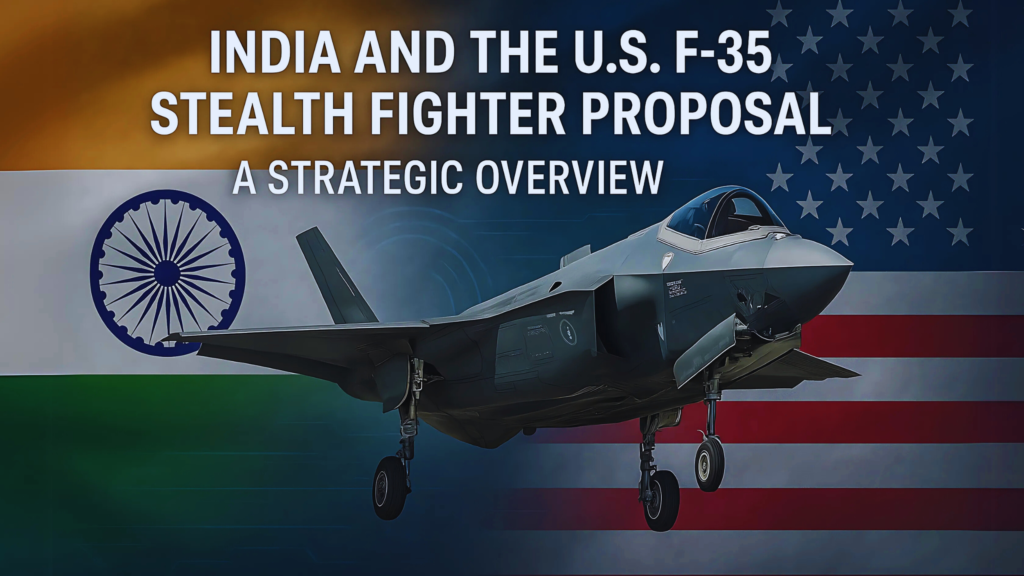In February 2025, during Prime Minister Narendra Modi’s official visit to Washington, D.C., U.S. President Donald Trump announced a proposal to supply India with Lockheed Martin’s F-35 Lightning II stealth fighter jets. This development signifies a potential deepening of defense ties between the two nations, marking a significant shift in India’s military procurement strategy.
Understanding the F-35 Lightning II
Overview
The F-35 Lightning II is a fifth-generation multirole stealth fighter developed by Lockheed Martin. Designed to perform ground attack, reconnaissance, and air defense missions, the F-35 is renowned for its advanced stealth capabilities, integrated avionics, and superior situational awareness.
Key Features
- Stealth Technology: The F-35’s design minimizes radar cross-section, allowing it to operate undetected in contested environments.
- Advanced Avionics: Equipped with sophisticated sensors and communication systems, the F-35 provides pilots with comprehensive battlefield information.
- Multirole Capability: Capable of executing a variety of missions, including air-to-air combat, air-to-ground strikes, and intelligence gathering.
- Variants:
- F-35A: Conventional takeoff and landing (CTOL) variant.
- F-35B: Short takeoff and vertical landing (STOVL) variant.
- F-35C: Carrier-based variant designed for catapult launches and arrested landings.
The Proposal: Details and Implications
Announcement and Strategic Context
President Trump’s announcement to supply F-35 jets to India aligns with broader efforts to strengthen U.S.-India defense relations. The proposal is part of a larger defense pact aiming to enhance military cooperation and interoperability between the two nations.
Current Status
As of now, the F-35 deal remains a proposal, with no formal acquisition process initiated. India’s Foreign Secretary Vikram Misri stated that the proposal is under consideration, and discussions are ongoing to evaluate its feasibility and alignment with India’s defense requirements.
Strategic Significance for India
Enhancing Air Superiority
Acquiring the F-35 would significantly bolster the Indian Air Force’s capabilities, providing a technological edge in stealth and network-centric warfare. This enhancement is particularly pertinent given regional security challenges and the need to maintain air superiority.
Diversifying Defense Partnerships
Traditionally reliant on Russian military hardware, India’s consideration of the F-35 indicates a strategic diversification of defense partnerships. Engaging with U.S. defense technology could lead to increased interoperability with Western forces and access to cutting-edge military innovations.
Challenges and Considerations
Cost Implications
The F-35 program is among the most expensive defense projects globally, with each unit costing approximately $80 million. Additionally, operational and maintenance expenses over the aircraft’s lifecycle are substantial, raising concerns about affordability and budgetary impact.
Operational Integration
Integrating the F-35 into India’s existing military infrastructure poses challenges, including the need for specialized maintenance facilities, pilot training programs, and compatibility with current systems. These factors require careful planning and resource allocation.
Geopolitical Dynamics
India’s potential acquisition of the F-35 may influence its longstanding defense relationship with Russia. Balancing ties with both the U.S. and Russia necessitates diplomatic finesse to maintain strategic autonomy and avoid alienating key partners.
Comparative Analysis: U.S. F-35 vs. Other Options
While the offers advanced capabilities, India is also considering other platforms, such as Russia’s Su-57 stealth fighter. Each option presents unique advantages and challenges, and India’s decision will hinge on factors like cost, technology transfer, and alignment with strategic objectives.
Conclusion: Navigating the Path Forward
The U.S. proposal to supply fighter jets to India represents a potential milestone in bilateral defense cooperation. While the deal promises significant enhancements to India’s air capabilities, it also entails considerable financial, operational, and geopolitical considerations. As discussions progress, India must carefully assess the proposal’s alignment with its defense strategy, fiscal constraints, and international partnerships to make an informed decision that best serves its national interests.




















